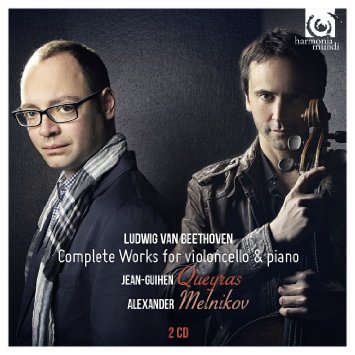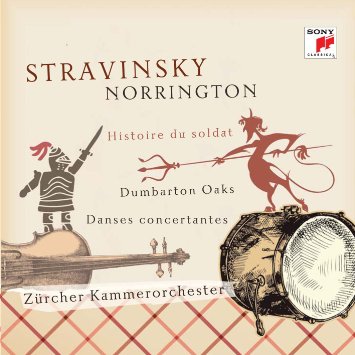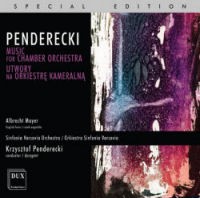You are reading the older HTML site
Positive Feedback ISSUE 75
Notes of an Amateur: Beethoven
Cello Sonatas; Norrington's Stravinsky; and Penderecki Chamber
Music.
Ludwig Van Beethoven, Complete Works for Cello. Jean-Guihen Queyras, cello. Alexander Melnikov, piano. 2 CD's. Harmonia Mundi HMC 90218384. A/B-ing musical performances can be as misleading as A/B-ing audio components: exaggerating differences that distract us from the specific virtues of each. Granted that other performances we've heard are the context in which we hear the one before us: they are what we know of what is possible for the music we are listening to. But having others too much in mind tends to reduce our judgments of what is before us to matters of taste. So this time out, in an renewed attempt to practice what I preach, I will not refer to the splendid recorded performances of Beethoven's cello sonatas by Starker & Bogin or Sebok, Rostropovich & Richter, Janigro & Zecchi or Demus, Finckel & Wu Han, Hewett & Müller-Schott, and Gastinel & Guy, which comprise the context in which I listened to this stunning new recording by Queyras & Melnikov. Jean-Guihen Queyras has, with powerful performances of Britten and Bach in particular, become one of the premier cellists of our times; Alexander Melnikov with strong performances of Beethoven's violin sonatas with Isabelle Faust and, to my ears, a definitive performance of Shostakovich's 24 Preludes and Fugues for Piano, has earned equal prominence on his instrument. Together they bring a great deal to this outing. The first thing we notice in their Beethoven is that they do not respect the music too much to go at it—with humor, imagination, and expressiveness. They go to the music. They are sufficiently major musicians to meet Beethoven on his own high, mercurial ground. Right from the first movement of Sonata No. 1, they go with him through beauty, grace, strut, virtuosity, sass, and even charm. And the character of their playing never lets up. It dramatizes how new this music must have sounded, actually was, in the mid-1790's. The musical decorum Beethoven inherited from Haydn and Mozart is out the window—and then back in again. Queyras and Melnikov insist on this music's place in the classical tradition just as they accompany the composer out of it to give us glimpses of the future. They make it dramatically clear that the composer felt there is room within the tradition for individual expression. What comes through these performances most conspicuously is the expression of a huge individual imagination working eloquently (not wrestling as is often claimed) with traditional musical tools and forms. This is as good as I've heard Queyras. His tone is rich, his touch varied but sure. He is bold, expressive, smooth, delicate in turn. Melnikov is strong and clear, percussive. His left hand holds its own with the growl of the cello. Part of what makes this Beethoven outing hold together as wonderfully as it does is the fairly rapid tempo—just a bit faster than I am used to but perfect for the occasion. The music must drive ahead, must not be held back. A great album, easily one of the best of the year. And yes, it belongs with the company of its predecessors.
Stravinsky, Norrington. Danse Concertantes, Dunbarton Oaks, Suite from L'Histoire du Soldat. Zurich Chamber Orchestra. Sony 88725470102. Roger Norrington, a highly respected leader of baroque choral music a generation ago and then a notoriously brilliant interpreter of nineteenth century orchestral music on period instruments (Beethoven, Brahms, Bruckner), has now released an exciting album of Stravinsky with the Stuttgart Chamber Orchestra which he has led since 2011. Stravinsky's music has to dance and fly but also keep its feet at least within reach of the earth. A great many of his interpreters press him too hard to get his music to dance, some others can't seem to get off him the ground. An hour with Norrington's Stravinsky may well make the competition sound either too assertive or elephantine. Norrington's secret, like Boulez's, has always been clarity of texture, even with modern instruments. Give each instrument its due and leave the blending to the venue or the ears of the audience. This is a way of going about things that can renew Beethoven and Brahms, but it is also ideal for Stravinsky. Norrington's Stravinsky sparkles, especially in contrast to that of someone like Colin Davis which many of us came to love for its warmth and even occasional indulgence. Norrington's Stravinsky is not at all stark or or clinical—it is actually good-natured. Clarity of instrumental voices does not have to mean undue sharpness of edge. Norrington is a nut for definition. He clearly has always loved individual instrumental voices. So does Stravinsky, which makes for a wonderful party. This is the most exhilarating Stravinsky I've heard in quite a while.
Penderecki. Chamber Works. Vol. 1 Various musicians. Dux 0780 As soon as the clarinet barked at me in the first of Penderecki's Three Miniatures for Clarinet and Piano (1956), I knew I was in for something special here. Penderecki may or may not be our leading contemporary composer but he is the one who is most conspicuously and irresistibly major in virtually everything he writes. Dux, the rising (1992) Polish label, is taking an appropriately leading role in bringing us some of his least known music—they have also released an album of the symphonies which I'll chase down one of these days to compare with Wit's on Naxos. And even these ‘smaller' works impress and engage. You don't have to know much about classical music or be a fan of contemporary modernism to hear how good this music is. To my ears his closest predecessor is Stravinsky. But where Stravinsky depends on structure within which he builds his modernist art, Penderecki is freer. His music is the natural progression from the great Russian's. A duo for clarinet and piano, solos for violin, cello, horn, and a pair of sextets. I hope this series goes on forever. Equipment used for this audition: Resolution Audio Cantata CD player; Crimson 710 preamplifier; Blue Circle NSP stereo amplifier; JM Reynaud Offrande Supreme, V2 loudspeakers; Crimson interconnects and speaker cable; and Volex power cords. Bob Neill is a former equipment reviewer for Enjoy the Music and Positive Feedback. Since 2004, he has been proprietor of Amherst Audio in Western Massachusetts, which sells equipment from Audio Note (UK), Blue Circle (Canada), Crimson (UK), Resolution Audio (US), Jean Marie Reynaud (France), and Tocaro (Germany).
|




